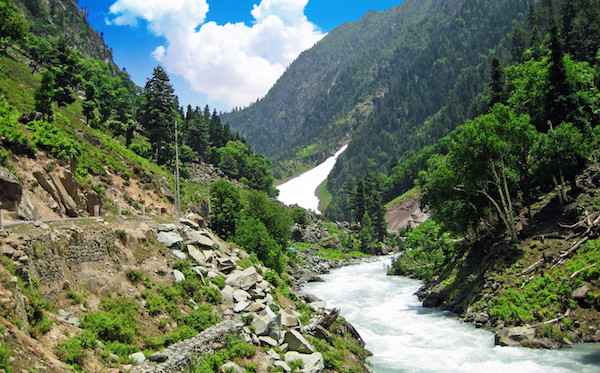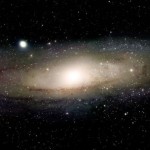Can Catholics and Atheists Agree on the Environment?
by Kevin Aldrich
Filed under Anthropology, Atheism, The Church
Tomorrow (June 18), Pope Francis will release his long-awaited teaching document on the environment and human ecology. With that in mind, I wrote this article to articulate some principles that underlie the Catholic environmental vision, with the hope that atheists can better understand it and perhaps find common ground. I don’t know if these principles have been set out systematically, but in my research, I have uncovered fourteen. My selection of them is my own, as is the order in which I present them. In this article I'll identify and explicate the first six, then we'll cover another eight in my next article.
The first principle is that God is the sole creator and sustainer of the universe. This includes the laws of nature implanted in things. Because God is also good in himself, we can say that God is the good creator.
A second principle is that everything God has created is good. In Genesis, when God looks at the entire creation, including the first man and woman, he sees that it is “very good” (Gen 1: 31). One reason the author of Genesis may have included this is that human beings have a recurring temptation to see physical reality, including the human body, as evil. Gnosticism, Manichaeism, and the Albigensian heresy are three examples.
An axiom of Catholic philosophy is: “All that is is good.” This is to say, everything which has being is good. It is easy to feel that wheat, wine, sunshine, and butterflies are good. But subatomic particles, uranium, arsenic, crocodiles, and killer whales are also in themselves good. Physical evils, such as floods, tornadoes, blizzards, man-eating tigers, and dangerous microbes, are bad for us but good in their being.
The third principle is that part of the goodness of the universe is that it has a design and a purpose. Things have an inbuilt order which we can discover, recognize, and cooperate with. Everything in the universe behaves according to laws, from subatomic particles, to atoms, to molecules, to chemical compounds, to cellular life, to plants and animals, even to the human body. Matter obeys the laws of physics, plants and lower animals obey their genetic programming, and animals follow their instincts. An amazing dimension of design is the potentiality in being. Assuming the Big Bang is correct, everything that exists now is a coming into being of potentialities inherent in the singularity.
In addition, everything in nature acts for an end or purpose. Every human organ, for example, is marvelously ordered to carry out a function: the eyes see, the fingers feel, the digestive system digests, and the sex organs reproduce. All technology is predicated on discovering and using things according to the way they naturally work. When Orville and Wilber Wright understood the physical laws of thrust, lift, drag and stability on three axes, and built a machine which could exploit these laws, they learned to fly. Hence, Artigas argues that modern science and technology have grown from the specific Christian premises that there is a natural order, we can know this order, and it is good to know it (Artigas 29-30). As Feser points out, it is not necessary that anything know its end or purpose in order to act toward it (Feser 35). For example, the human reproductive system produces new human beings without any awareness and it produces human beings, not bonobos, carrots, or lead.
The fourth principle is that the human race is singular and the summit of creation. Man is singular on the earth in that there is nothing else like him. There is no other being in the physical world—at least on planet earth—with a nature which makes it possible for it to exercise reason and free will. This is one of the things we interpret Genesis to mean when it reports that God made man, “in the image and likeness of God” (Gen 1:27). As awe-inspiring as are the number, variety, complexity, and beauty of the creatures of the natural world, humans alone possess oral and written symbolic language, mathematics, art, music and philosophy.
I think it is also true to say that man is like everything else . . . but more. Man is the summit of creation because he holds within himself all the lower levels of the created world. His body is made up of subatomic particles, atoms and molecules, which obey the laws of physics. He is composed of chemicals which obey the laws of chemistry. He is a conglomerate of trillions of cells which act just like all other cellular life. His body carries out all kinds of operations automatically, like plants and animals do. He has a body which has instincts and emotions, like the higher animals. While contemplating the wonders of the natural world, the Psalmist exclaims amazement that God has made man, “little less than God, and dost crown him with glory and honor,” giving him dominion over all His creatures (Ps. 8: 3-8). We do have god-like powers.
The fifth principle is that the earth is for our use. This principle is perhaps the hardest Christian environmental truth for modern people to accept, although almost no one had a problem with it until about 1960.1 The earth and its creatures exist for us, not us for them. In Genesis, man receives the command to “subdue” the earth. He possesses “dominion” over the animals and is “given” the plants to eat.
Why is it morally legitimate for us to “use” creation? According to the Catholic vision, there is a fundamental difference between human beings and everything else in creation. Human beings have absolute value: we are ends in ourselves. According to the Vatican II Pastoral Constitution on the Church in the Modern World, man is “the only creature on earth that God has willed for its own sake” (Gaudium et spes 24). The rest of creation is of limited value: it is a means to an end. This is already seen in God’s mandate to Adam and Eve to subdue and use the things of the earth. In a highly technical explanation of this in his Summa Contra Gentiles, Thomas Aquinas writes, in reference to “subsistent intelligences,” by which he means men, “the good things which are given them . . . are not given them for the profit of any other creature: while the gifts given to other creatures by divine ordinance make for the use of intellectual creatures.” In other words, the gifts which man is endowed with are for his own benefit, not for the benefit of the creatures below him. On the other hand, the good things lower creatures possess are for our benefit (and the benefit of other lower creatures). They are for us; we are not for them. We are not designed to be shark food or malaria hosts, even though we can be those things.
This is why the earth’s ecology is at the service of human ecology and not vice versa. According to Pope Benedict XVI in his January 1, 2010 World Day of Peace Message, If You Want to Cultivate Peace, Protect Creation (CPPC), “Our duties towards the environment flow from our duties towards the person, considered both individually and in relation to others” (CPPC 12). Note that our duties towards the environment do not flow from any “duties” towards trees, dolphins, the air, or the earth as a whole. For example, the Catechism of the Catholic Church (CCC) tells us,
[I]t is legitimate to use animals for food and clothing. They may be domesticated to help man in his work and leisure. Medical and scientific experimentation on animals is a morally acceptable practice if it remains within reasonable limits and contributes to caring for or saving human lives. (CCC 2417)
On the other hand, an environmental policy or practice that does real harm to people to benefit “the environment” is wrong. For example, some environmental activists hammer spikes into trees to “save” them and to punish the logging industry. If the spikes are discovered, they must be laboriously removed, and they lower the economic value of the trees. If they are not found, they could physically injure a logger or sawmill worker when the saw hits the hard object.
If it is legitimate for man to use creation, may he use it any way he wishes? As we will see later, the answer is no.
This brings us to the sixth principle: Stewardship is man’s God-given mandate to direct wisely the development of the earth. If we look back over the five principles articulated so far, one could argue that the first great principle of the Catholic environmental vision is that God is the good creator of everything that is. The second is that man is God’s steward of creation. The principal of stewardship is also the answer—or at least an answer—to those who (falsely) say Christians believe God has given them license to rape the environment. A steward is not the owner of a good thing but rather the one who is entrusted with its use and care. The owner of the entire natural world is God who has given mankind the order to fill the earth and subdue it. Man’s stewardship imposes responsibilities on him.
Man’s stewardship includes respect for God’s creation. A person’s abuse of creation is wrong because it degrades him and is an injustice to other people on earth and to future generations. However, it is not wrong because of any inherent rights which lower created things possess. Abuse of creation is also wrong because it is a kind of insult to God who has created it good.
Man’s actual practice of stewardship can be seen in human history, which is an astonishing account of man’s dominion over and use of the goods of the earth through discovery, adaptation, and technology. We rightly think of our age as one of an explosion of knowledge and of astounding scientific and technological progress. But the discovery and use of fire, the domestication of animals, and the development of agriculture all occurred in human prehistory.
Stewardship is also not optional. As Pope Benedict XVI points out, God has created the world with a certain “grammar” which includes “giving man the role of a steward and administrator with responsibility over creation, a role which man must certainly not abuse, but also one which he may not abdicate” (CPPC 13). Whether anyone likes it or not, man is master of creation. Therefore, he has a responsibility.
In the next post, I will articulate the final eight principles. After that, if there is interest, I can start applying these principles to specific environmental issues.
Related Posts
Notes:
- Here is a link to a fascinating video from 1946 on the coast redwood logging industry. The view presented is one that is fully appreciative of the history, age, majesty, beauty and biology of the redwoods. Yet there is displayed absolutely no compunction about cutting them down because they are useful to man. ↩
Note: Our goal is to cultivate serious and respectful dialogue. While it's OK to disagree—even encouraged!—any snarky, offensive, or off-topic comments will be deleted. Before commenting please read the Commenting Rules and Tips. If you're having trouble commenting, read the Commenting Instructions.













